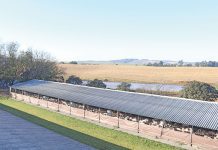
Photo: Courtesy of Umvoto Africa
The first step in successfully constructing a borehole is knowing what you want. How much water do you need and what will you use it for? Irrigation? Domestic supply? Stock watering?
This will affect the water quality required. If you need water for toilet flushing and sanitation, for example, a low-yielding borehole with saline water will be sufficient. But it will be of no use if you require high quality water for crop irrigation.
READ: Boreholes: are you being ripped off
Do your homework before constructing a borehole
Check with neighbours to see who has a borehole before constructing a borehole. If they do, what is the quality like and what is the yield? This will give you an idea of your chances of finding water. Also consult a geologist or hydrogeologist (groundwater specialist) with experience in the region where you farm.
He will be able to tell you immediately, before any detailed assessment is done, if you’re likely to get a high-yielding borehole of 5l/s or more, or a low-yielding borehole (less than 1l/s).
After this, he can assess the surrounding geology and subsurface conditions to see if the site is underlain by poor-yielding aquitards and aquicludes (rocks that retard water flow, usually forming barriers or seals above aquifers).
Understand the risk
While the driller should exercise care and diligence, he is not responsible for the water quantity or quality.
READ: Keep your water clean
Groundwater assessment
This is a phased assessment, starting with a desktop study and followed by a field visit and borehole siting.
The assessment should be divided into phases, each with its own costs, so that you don’t have to pay a large amount of money up front.
The desktop assessment, for example, may indicate little chance of good quality, high-yielding groundwater (despite your neighbour’s experience). If it’s positive, you can proceed with the actual siting and drilling.
Be aware of costs
There could be additional costs for drilling through certain rock. The contractor might have to set up a base camp where staff are fed and housed. If a local community is involved, you will have to factor in visits and meetings.
The driller should be able to provide a bill of quantities – that is, the cost per unit of drilling a certain diameter at a certain depth.
Instead of a bill of quantities, though, many farmers might favour a lump sum instead, with a single price per borehole. A lump sum contract may prevent over-drilling, but it can also encourage under-drilling, with boreholes not being drilled to the required depth.
Supervision
This should include witnessing and certifying critical milestones, as well as ensuring that boreholes are drilled and completed to specification. Supervision of drilling by a geologist/hydrogeologist can ensure that the correct data (depth, yield and quality of water strikes) is collected during drilling. This will assist in any future pumping tests or licensing requirements.
Site meetings
These review the progress and quality of the work. At the meeting, the contractor should submit a progress report and detail any new challenges. Not all issues can be resolved on site and a consultant may have to be called in.
Payment
This should be based on actual work completed. Usually, 5% to 10% of each stage valuation sum is held back. Half of this retention fee is released after completion of the work. The balance is paid after the defects liability period.
Completion time
By the completion date, the contractor should have finished all the work, removed the material and returned the site to the pre-existing condition as much as possible.
Insurance
Insurance for damage should be taken out with a reputable company by the contractor.
Defects liability period
This is usually six to 12 months after completion and handing over of each borehole. During this period, the contractor is obliged to correct defects at his own expense.
Borehole completion
When drilling is finished, fit a lockable cap to protect the borehole from vandalism, such as people throwing stones down it.
With an artesian borehole (where groundwater flows out under its own pressure) you will need a sealed wellhead. It is recommended that a borehole has a form of physical identification.
The borehole number should be stamped into a metal plate on the pump stand or borehole plinth, along with other information such as depth and completion date. Borehole data, including GPS co-ordinates, depth and yield, must be submitted to the Department of Water and Sanitation in order for the borehole to be recorded on the National Groundwater Archive, even if water use registration/licensing is not required.
Handover
Check that the driller has met all the contract requirements, the installation is functioning properly (if pumping equipment is installed) and all the required data has been collected and submitted. Also, make sure that the site has been restored to the pre-existing condition as much as possible.
Pumping tests
These tests, along with subsequent analysis by hydrogeologists, can determine the safe, sustainable rate at which a borehole
should be pumped, as well as what depth to install the pumping equipment. They will also help to ensure that the borehole does not dry up over time. Pumping tests are also a requirement of any groundwater use licence application before constructing a borehole.
Contact Umvoto Africa at 021 709 6700 or [email protected]. Visit www.umvoto.com.
Contact the Borehole Water Association on 011 447 0853 or [email protected]. Visit www.bwa.co.za.











